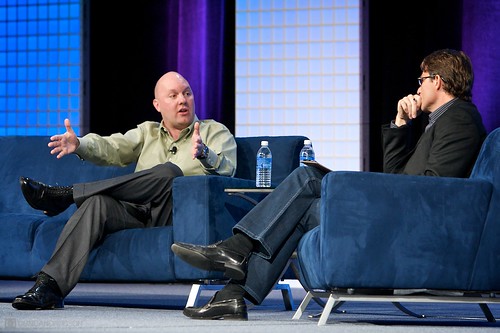 I had the illuminating pleasure of spending a few hours today attending the keynotes and browsing the innovations on the floor at the O’Reilly/TechWeb conference, Web 2.0 Expo SF. These have become quite vibrant affairs with NY, European & (I think) Japanese iterations now on the annual conference schedule.
I had the illuminating pleasure of spending a few hours today attending the keynotes and browsing the innovations on the floor at the O’Reilly/TechWeb conference, Web 2.0 Expo SF. These have become quite vibrant affairs with NY, European & (I think) Japanese iterations now on the annual conference schedule.
(Keynote photo of John Battelle on stage with Marc Andreessen at Web 2.0 Summit SF 2008 by James Duncan Davidson.)
This spring’s SF show attracted about 8,500 web-savvy geeks and associates and I was impressed with the consciousness of both the collaborative conference editorial orientation as well as the folks in attendance. Top level insights of the day were provided by John Batelle’s interview with Mosaic browser creator, Netscape founder and Ning.com do-it-yourself social network entrepreneur Marc Andreesen who offered a interesting historical perspective on why the web browser will persist and warnings about the “coming nuclear winter” with regard to the economy. Author and Harvard/Oxford professor, Jonathan Zittrain also offered a quite thoughtful “big think” analysis of how and why we should take security and Web 2.0 business concerns more seriously.See his book, The Future of the Internet… and How to Stop It for more details. We’ll all be glad if you do.
for more details. We’ll all be glad if you do.
Beyond these considerations, Web 2.0 seems to be alive and well with not only ample opportunities for open source collaboration, but with myriad kinds of mashups that bring remarkable power to the web browser.
Many folks are familiar with the Facebook and MySpace plug-ins that let individuals do more… (as one presenter said, “we’re no longer browsing the web, we’re creating it”), but there are now many more web-based tools that let you create powerful online applications, plug-in widgets and whatever, without the need of any desktop software. For example:
- At the most basic level, Slide let’s you create custom slide show widgets from digital photos that you upload to PhotoBucket or Flickr
- For multimedia types, I’ve been impressed with Sprout Builder which is kinda like a web-based Flash authoring tool for the rest of us. But in this case, you get embed code so that your Flash widget can be posted anywhere and can spread virally
- Zude.com hypes itself as a social computing platform, but what I liked is its ability to let you drag and drop virtually any kind of web content into a Zude page for online publishing and sharing
- and for the more advanced gear heads, Coghead.com offers a platform, also in a web browser of course, that let’s you build interactive business processes, like lead capture for example, all in a drag and drop environment. Who needs code? 😉
What I find most interesting is the way that all of this functionality has become web browser-based. It seems that we are destined to do all of our computing in the cloud. In any case, the creativity, collaboration (amongst people as well as interconnected bits and bytes) and the communication channels are continuing to get ever more powerful… and all of this is really just getting started. You ain’t seen nothing yet.
Thanks O’Reilly for giving me a glimpse of the future as it is appearing now… in browsers near us all.

